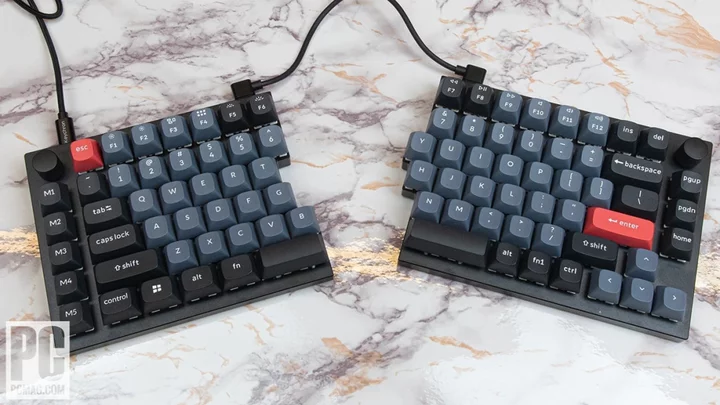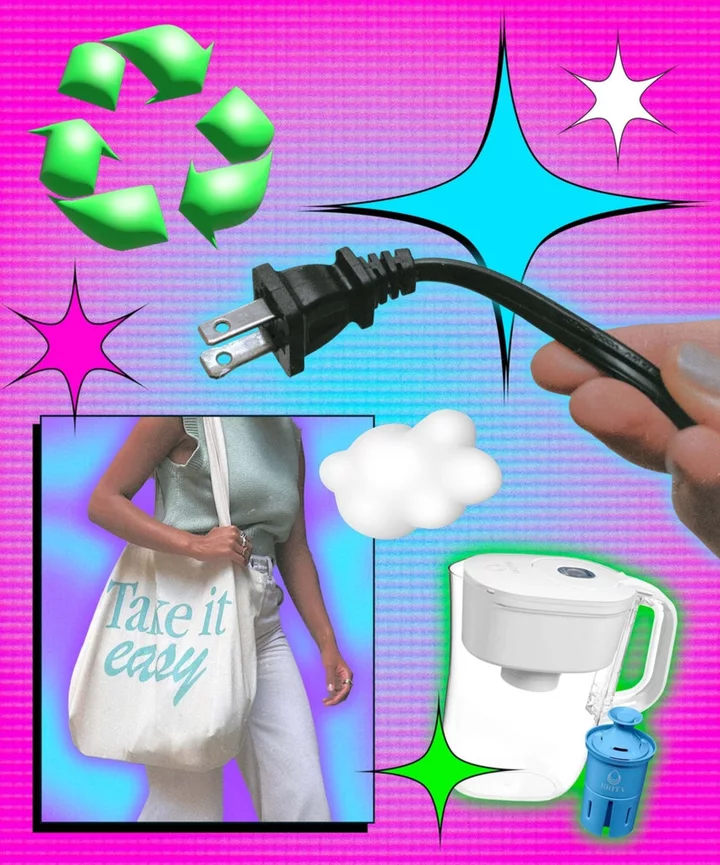As you can imagine, we do a lot of typing here at PCMag, so we’re always on the lookout for ergonomic keyboards to help with the aches, pains, and other complications of constant keyboard use. The latest of these is the Keychron Q11, a split-design mechanical keyboard that uses a short USB-C cable to link the halves. At $205 for a fully assembled model, it’s definitely one of the more expensive options for an ergonomic keyboard, rivaling high-end mechanical boards made for gamers or enthusiasts. Although it's well-built, in testing we found the Q11 to fall a bit short of the level of comfort we expect from such an expensive ergonomic model, so it doesn't unseat our current Editors' Choice pick for split-design keyboards, the Cloud Nine ErgoTKL.
The Design: A Nearly Equal Split
The Keychron Q11 is a split-design, tenkeyless (TKL) mechanical keyboard. (TKL boards lop off the number pad in the interest of compactness.) The version we tested comes equipped with Gateron G Pro Red key switches, a linear style of switch. Keychron also offers this board with Gateron G Pro Browns. If neither of these key-switch options appeals to you, and you're up for a bit of DIY customization, a barebones model is also available for $185, which lets you supply your own switches. Since the Q11 is hot-swappable, it should be as easy as plugging them in.
(Credit: Molly Flores)If you do opt for the barebones model, you’d also need to supply your own keycap set. The ones included with the fully assembled Keychron Q11 have a darker tone of purple for the alphanumeric keys, dark gray for most of the others, and red for the Enter and Escape keys. The keycaps are double-shot PBT, and although the keyboard has south-facing LEDs, the caps have no shine-through feature to allow the legends to glow like you'll find on boards like the SteelSeries Apex Pro Mini.
The box contents include an extra pair of keycaps for a Mac layout (Command and Option keys), a keycap puller, a switch puller, and a mini screwdriver. The mini screwdriver is a nice touch, as it's really all you need to get inside the Keychron Q11 for truly advanced tweaking. All the screws are easily accessible on the bottom of the keyboard. Tinkerers interested in additional modifications past swapping key switches should have no issues breaking into this one.
(Credit: Molly Flores)As is common with split keyboards, the Q11 comes with a short USB-C-to-USB-C cable to bridge the two halves. With the cable unplugged, it's possible to use the left half by itself via the USB-C port at the extreme left of the back edge, right next to a toggle switch used to swap between Windows and Mac modes. The cable carries power to light the LEDs and transmits your key presses. Theoretically you could supply your own USB-C-to-USB-C cable and have your keyboard halves as far apart as you’d like, but for our testing we kept to the stock cable, which is about 4 inches long.
(Credit: Molly Flores)The space bar is split into two parts to facilitate the split design, with the right portion being the larger one. That's possibly to accommodate right-handed people, but each half of the keyboard has its own rotary knob to ensure easy access for whichever hand is your dominant one. The left portion has five macro keys running down the left edge, while the right side has the Page Up, Page Down, and Home keys arrayed in a similar column.
(Credit: Molly Flores)The split design of the keyboard isn’t a clean slice down the middle, but rather a zigzag. The cut divides the F6 and F7 keys, the 6 and 7 keys, the T and Y keys, the G and H keys, and the B and N keys. This zigzag look allows the keyboard to fit together like a puzzle if you'd prefer to use it in the standard non-split layout. And if you're a split-keyboard novice, this actually works to your benefit. Typing on the Q11 takes some getting used to, so if you’re getting frustrated with acclimating to the split design and just need to get some work done, you can recombine the keyboard halves and continue typing.
Testing the Keychron Q11: You'll Need to Retrain Your Brain
Because of the split design, we have two different typing styles to evaluate. A test using the keyboard speed test website Monkeytype showed a pretty steep learning curve in either configuration. In the Q11's combined "normal keyboard" mode, speed wasn’t much of a concern. I was still able to reach my 63-word-per-minute average after a couple of attempts. The split design was a lot harder to learn, though, knocking me down to 58 words per minute in my best Monkeytype attempt.
If you're using a split-design keyboard for the first time, and you rely on your own mental map of where the keys are without using the indentations on the F and J keys, you’ll find yourself reaching for keys when they aren’t there. The dual space bar also proved a bit confusing, as I’d sometimes over-reach to hit the larger bar I was expecting. A few weeks to retrain your muscle memory would probably fix these issues. I found myself growing more comfortable typing over time.
One of the biggest reasons to switch to a split keyboard is to relieve strain on your shoulders. Separating the keyboard halves farther apart sets your shoulders in a more relaxed position than they would be if typing on a conventional keyboard. The Q11 definitely helps alleviate that stress, but it still falls short of other ergonomic-keyboard designs. We would’ve loved an inclusion of some angled feet, for example. Instead, this board lays flat on the desk with no additional typing angles possible. For certain people with wrist issues (such as carpal tunnel syndrome), this could be a deal-breaker for using the Q11 for extended periods.
(Credit: Molly Flores)Keychron sells a wrist rest separately via its online store, but not a tenting kit like you'll find with the Kinesis Freestyle Edge RGB Split, which has a “lift kit” available as an add-on. Members of the maker community have designed Q11 tenting kits, essentially 3D printed sets of slopes to lay the halves on, but it's a shame Keychron offers no official option.
Extensive Customization Options via VIA
Many Keychron keyboards opt for VIA as their software utility of choice. VIA is an open-source keyboard configurator for QMK-based keyboards that you access through a website, with no additional installs needed. Using VIA allows you to remap all the keys on the keyboard, apply lighting effects, assign custom macros, and even load custom keyboard profiles. Most of these features you can control from the Q11 itself, but it’s nice to be able to visualize them on a screen.
(Credit: VIA)VIA also has a number of specialized diagnostic tools for the most enthusiastic members of the keyboard modding community, including a key tester to test for dead switches, a tool not commonly found in other keyboard utilities. You can even set the behavior of each of the rotary knobs separately. By default, both knobs control volume, but you can set one to, say, scroll through text or to control magnification instead.
Verdict: A Solid, if Pricey, Way to Learn the Splits
Whether or not the Q11 is billed as a premium ergonomic keyboard, its price cements it as one, and it does meet some of our expectations for the category. The split design helps limit shoulder strain during long sessions, for instance, not to mention it's just cool. The act of splitting the keyboard apart activates the “elite tech nerd” neurons inside our brains.
But we can't ignore a few issues here—small changes that, if Keychron implemented them well, would level up the Q11. As it stands, the board falls a bit short. It’s a solid device made of quality materials and based on a proven ergonomic design, but alternatives like the Cloud Nine ErgoTKL offer more for less. The ErgoTKL has a detachable wrist rest, USB passthrough, and the option for a lift kit, making it a better, and better-value, fit for our achy arms.









